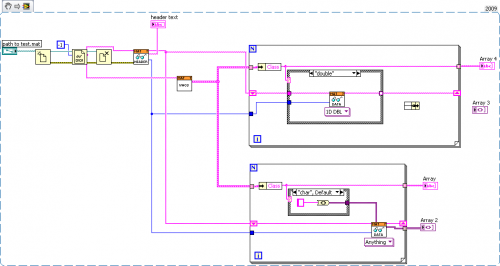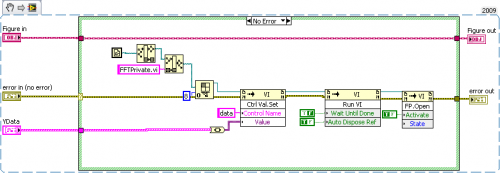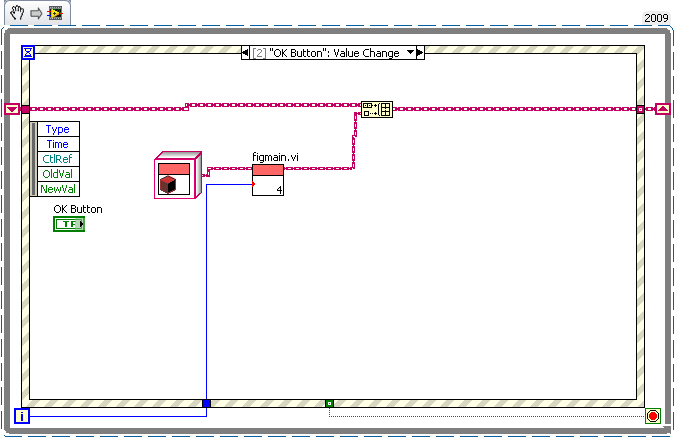-
Posts
150 -
Joined
-
Last visited
Content Type
Profiles
Forums
Downloads
Gallery
Everything posted by MartinMcD
-
Hello, My employer is currently looking for a LabVIEW engineer, if you are interested please contact Steven Morris (recruiter) at steven.morris@dyson.com. Thanks, Martin Job Purpose: To provide design solutions for machine control, instrumentation and data acquisition using National Instruments LabVIEW. Support and maintain systems throughout Dyson Ltd. Principal Accountabilities: Design of software using National Instruments LabVIEW for control and data acquisition Support existing National Instruments LabVIEW systems Design, manufacture and installation of safety and machine control circuits Design bespoke signal conditioning PCBs Write specifications and manage sub-contract design and manufacture resource Skills Knowledge & Experience: Essential - HND in Electrical/Electronic engineering with 5 years experience Attendance at National Instruments LabVIEW Intermediate 1&2 with 5 years programming experience Desirable Working knowledge of National Instruments hardware product range PCB design (Mentor Graphics) Experience of PLC programming Formal training in CE directives on Machinery, Low Voltage and EMC. Knowledge of BS7671 Electrical Installations (IEEE 17th Regs) Behavioural: The ability to communicate appropriate, concise and accurate information across the business (technical and non-technical) is essential for the successful applicant. You will be a highly driven individual who strives for accuracy & quality in work delivered. You will be able to solve problems in a logical way, pre-empt future problems and seizing opportunities without waiting to be told. The proven ability to work as part of a team or un-supervised to an agreed goal or set of deliverables is imperative.
-
Hello there, I'm writing an app where I have a tab control on the front panel. When the vi is run the window is maximised. I don't know what the size of the monitor will be so I'd like to be able to align the tab control relative to the page (as you would on a web browser for example) such that when the page is maximised it stays centrally positioned. Is there an easy/built in way of doing this does anyone know please? Thanks very much, Martin
-
Hello everyone, I am writing a few applications that will be used my people within our office. Assuming that to use the application you must install a copy of it on your local hard drive then I would like the user to be notified if a newer version is available and offer them the chance to upgrade. One way I could do this is by changing the filename of the executable when I build a new version, eg from myApp_v1.exe to myApp_v2.exe. Then it is easy to compare file names and if newer copy the newer version across. However, this seems a bit of a 'hacky' way of doing things. I would like to compare the build version numbers instead. I know how to get the build number from within a build vi but how do I find out what it is on the remote (and possibly newer) executable? If you have any pointers/tips it would be very much appreciated. I need to implement something or I will have to keep on track of who has the software installed so I can update them manually & with >500 engineers that would be a real pain. Thanks very much, Martin
-
That's fantastic, thank you both very much. All the best, Martin
-
Hello, I'm writing an audio app. I'd like to have a menu item 'Audio Device Properties' and another 'System Volume Control' that launches/opens the appropriate Windows system control panels. ie. 'Sounds and Audio Device Properties' from the Control Panel and Volume Control. Is this possible please? It's just a little thing but it would make my app nicer to use. Thanks, Martin
-

Getting a list of sound devices in the system
MartinMcD replied to MartinMcD's topic in LabVIEW General
That's perfect, thank you very much for the help Shaun. Cheers, Martin -
Hi there, I would like the user of my app to be able to select which audio device/soundcard to read from. At the moment I am just reading from Device 0. This works because Device 0 is the soundcard if no external device is plugged in and then any device I add is assigned to Device 0 instead. This is a bit limited though. I know there must be a Windows api call to get an enumerated list of the active devices (in fact the express vi for sound capture has just this list). Does anyone know how to do it please? Thanks very much, Martin
-
Hello again, In the snippet below, I am trying to read a file without knowing what data types are in it. I'm using Whos to get the variables cluster and then calling the appropriate library function for each variable type. I've tried two approaches - reading using 'Anything' and reading using the right type but in both cases I end up with data in a format that is difficult to use - arrays of variants or needing to build a cluster at runtime etc. Is there a better/correct way that I am missing please? Thank you, Martin
-
Hello there, This library sounds great & exactly what I'm looking for. However I'm struggling to get started at reading a mat file. Does anyone have an example that they'd be able to share with me please? Thanks very much, Martin
-
Hello there, I'd like to use the dlls provided by Matlab for opening & reading .mat files in Labview. I'm trying to get started and figure out what commands I need to send where. Has anyone had any experience with this that they could share with me please? Thanks very much, Martin
-

Cllusters containing latching buttons
MartinMcD replied to MartinMcD's topic in Application Design & Architecture
Thank you for the reply. I did realise it was the fact that the button was in the cluster that was the cause of the problem, but I'd put them in there to try and organise things 'properly'. I've realised that my approach was inelegant and have implemented a subpanel solution which is proving to a much 'nicer' implementation overall. Thanks for the help, Martin -
Hi there, I am developing an app with a tab control. Each tab contains a cluster with the controls relevant to that tab in it, including a couple of buttons. Now, I've just realised of course that I can't use latching buttons properly because the button state does not get reset when the 'Value Change' event goes off - normally I would include the terminal in the event case of course. Is there a way of getting this to work elegantly or am I just fighting when I should be using subpanels instead? Thank you, Martin
-

Sub VIs launching themselves on project-open
MartinMcD replied to MartinMcD's topic in Application Design & Architecture
Ahh, yes - thank you, that was it! I'd been playing with the setting when trying to figure out how to launch separate windows and had forgotten to change it back. Thanks very much! Martin -
Hello there, I have an application with a main vi that can launch sub-vis as separate widows/processes. These child windows contain a plot. I launch the child window using the code snippet attached. This all works perfectly. However, when I open the project file it so happens that the child windows open as well, even before I have opened or run my main vi. I don't understand how they are being launched. The same thing happens if I build an executable. Please can anyone help? Thank you, Martin
-

launching multiple vi windows of same type
MartinMcD replied to MartinMcD's topic in Application Design & Architecture
Thank you very much, that's a massive help. -
Hi again, I'm trying to get my head around this... In response to a user request (button press) the main vi will 'spawn' a new child window which will then be able to contain a graph etc. If the user clicks the button again, a second window gets launched of the same type - able to display a graph. I've set it up at the moment so that a new instance of a class is created on a button class and then that classes graphDisplay.vi is called, with it's front panel set to display on call. This works okay for the first button press but not after that. Can anyone help to point me in roughly the right direction please? I'll keep looking myself and post back if I get it. Thanks, Martin this is what I have at the moment. The figmain.vi has a control on the front panel which shows the numeric value passed in - this is always right, it is just that the previous versions to not stay open. I think I need to look at spawning a daemon (just getting my head round these after reading some examples) but then I like the idea of an OO approach.
-
Hmmm, it seems to be working now. I was just about to change it so that when the window is resized an event gets the new width/height and re-sets the position of the indicator appropriately.
-
Hello, I have a front panel graph which I've set to resize as the front panel is resized. This works perfectly. I then have a string indicator which I use to give the graph a title, I update this each time a file is loaded for analysis. I'd like to be able to fix the alignment of the string so that it stays at the top-centre of the graph as it is resized. If I group the title and graph then the string box itself is scaled which I don't want. Is this possible please? Thanks, Martin
-
Hello there, When I plug a USB daq device into my laptop, the NI Device Monitor notices it and tells me it's ready to go. Are there any ways of being notified by the Device Monitor or someone else, when the list of active devices changes & without having to poll the list which is what I do at the moment. Thanks, Martin
-
Fantastic, thank you, Amazon will be sending me a copy of Head First Design Patterns very shortly. I've trying to get my head around how I can ditch the QSM, which I'm keen to do for a learning-exercise if nothing else, but can't get my head around it at the moment - I still need (I think) a UI and a 'doing things' loop to keep the responsiveness in the system, each time I think about it I just end up at the QSM-with-OOP again. I shall keep thinking & reading... Thanks again for the tips.
-
Hi there, I have developed an application using the event-driven QSM pattern. However, where in the past my main state machine would contain the usual collection of sub-vis I have implemented an OOP solution. It has been a bit of a learning curve but I'm very impressed so far with the benefits. I have 5 classes looking after FileIO, plotting an FFT etc. It all works nicely. My question is one of elegance I think... This is an example scenario: - The user selects Settings->FFT Settings... from my custom menu - This action is picked up by the event handler which enqueues an enumerated state 'getFFTSettings' - This request is picked up in the state machine and in the getFFTSettings state I unbundle the FFT class object and pass it into and out of the 'cFFT:getSettings' public member and away we go - a dialog box pops up, populated with the current class data and giving the user the option to change it etc. All fine. What I'm wondering is whether this is a sensible way of doing things? I have lots of states in my state machine to handle all sorts of different things, it all works nicely but the 'loveliness' of the OO implementation seems to be reduced by having the extra step of the state machine. Am I worrying about nothing or is there a design pattern that I should be reading up on which could help me build a better solution? Any thoughts would be great - just pointers on things I should be reading up on would be smashing. Thanks very much, Martin
-
Hi there, Our company is shortly going to be making the jump from 8.2 to 2009 (yipee). I'm just being asked if there are any known issues either with making the jump or with 2009 itself. Any tips? Thanks very much, Martin




